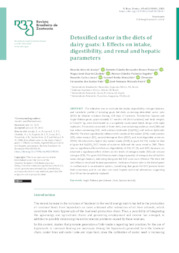Detoxified castor in the diets of dairy goats: I. Effects on intake, digestibility, and renal and hepatic parameters.
Detoxified castor in the diets of dairy goats: I. Effects on intake, digestibility, and renal and hepatic parameters.
Autoria: ARAÚJO, R. A. de; POMPEU, R. C. F. F.; CÂNDIDO, M. J. D.; ROGERIO, M. C. P.; LUCAS, R. C.; MARANHÃO, S. R.; SANTOS NETO, C. F. dos; NEIVA, J. N. M.
Resumo: The objective was to evaluate the intake, digestibility, nitrogen balance, and metabolic profile of lactating goats fed diets containing detoxified castor cake (DCC) by alkaline solutions during 150 days of lactation. Twenty-four Saanen and Anglo Nubian goats, approximately 17 months old (first lactation) and body weights of 43±2.97 kg, were distributed in a completely randomized block design with eight replicates. Treatments consisted of three diets, one containing soybean meal (SM) and two others containing DCC, with calcium hydroxide [Ca(OH)2] and sodium hydroxide (NaOH). The diets significantly influenced the intake of dry matter (DM), crude protein (CP), ether extract (EE), neutral detergent fiber (NDF), and total digestible nutrients (TDN). We observed a higher dry matter intake (DMI) in goats fed SM, similar to that of goats fed Ca(OH)2 DCC. Intake of nutrients followed the same trend as DMI. There was no significant effect of diets on digestibility of DM, CP, EE, and NDF; however, we observed a significant effect of diets on the levels of nitrogen intake (NI) and urinary nitrogen (UN). The goats fed SM consumed a larger quantity of nitrogen, but all had the same nitrogen balance, indicating that goats fed DCC were more efficient. The diets did not influence renal and hepatic parameters. Inclusion of castor cake in the diet of goats in confinement is an attractive option, considering that goats fed DCC present lower feed conversion, and its use does not cause hepatic and renal alterations, suggesting that SM can be completely replaced.
Ano de publicação: 2020
Tipo de publicação: Artigo de periódico
Unidade: Embrapa Caprinos e Ovinos
Palavras-chave: Alimento Para Animal, Anglo Nubian, Animal feeding, Animal nutrition, Cabra Leiteira, Caprino, Dairy goats, Desintoxicação, Destoxificação, Diet, Dieta, Farelo de soja, Nutrição Animal, Persistence, Ricin, Ricina, Ricinus Communis, Ruminant nutrition, Saanen, Soybean meal, Torta de mamona, Toxicity
Observações
1 - Por padrão são exibidas publicações dos últimos 20 anos. Para encontrar publicações mais antigas, configure o filtro ano de publicação, colocando o ano a partir do qual você deseja encontrar publicações. O filtro está na coluna da esquerda na busca acima.
2 - Para ler algumas publicações da Embrapa (apenas as que estão em formato ePub), é necessário ter, no celular ou computador, um desses softwares gratuitos. Sistemas Android: Google Play Livros; IOS: iBooks; Windows e Linux: software Calibre.
Acesse outras publicações
Acesse a Base de Dados da Pesquisa Agropecuária (BDPA) para consultar o acervo completo das bibliotecas da Embrapa.

